Metal-free direct C(sp3)-H functionalization of 2-alkylthiobenzoic acid to access 1,3-benzooxathiin-4-one
2021-04-02KeYangYiLiMengjieSongShengfeiDaiZhengYiLiXiaoqiangSun
Ke Yang*,Yi Li,Mengjie Song,Shengfei Dai,Zheng-Yi Li*,Xiaoqiang Sun
Jiangsu Key Laboratory of Advanced Catalytic Materials & Technology, School of Petrochemical Engineering, Changzhou University, Changzhou 213164, China
ABSTRACT Metal-free direct α-C(sp3)-H intramolecular cyclization of 2-alkylthiobenzoic acid in the presence of Selectfluor is described.This novel strategy provides a facile and efficient method to access important 1,3-benzooxathiin-4-one derivatives with good functional groups tolerance and yields.
Keywords:Metal-free C(sp3)-H functionalization Selectfluor 1,3-Benzooxathiin-4-one Organic synthesis
1,3-Benzooxathiin-4-ones have received much attention due to their vital use in a large number of insecticidal and fungicidal agents, crop protection agents, and food additives (Fig.1) [1-3].Previous methods for the synthesis of 1,3-benzooxathiin-4-ones mainly rely on the cross-coupling of thiophenol derivatives with alkynes [4-7] and alkenes [8,9], or the Pummerer reaction of sulfoxide derivatives [10,11].However, these methods always suffer from some drawbacks, including the use of odour smelling thiophenols, the requirement of pre-functionalization of thioethers or limited substrate scope.
Recently,direct C-H bond functionalization has been regarded as one of the most effective and direct methods for the construction of C-C or C-heteroatom bond [12-24].Within this reaction class, transition-metal mediated C(sp3)-H bond functionalization of thioether derivatives has been developed to synthesize 1,3-benzooxathiin-4-ones.The Porcel group reported the allylic C-H bond intramolecular cyclization of 2-(allylthio)benzoic acid mediated by the excess amounts of AgOAc(Scheme 1a) [25].Moreover, our group also demonstrated the Ag2O-promoted intramolecular C(sp3)-H bond functionalization of 2-methylthiobenzamide and sequential acidolysis to access 4Hbenzo[d][1,3]oxathiin-4-one (Scheme 1b) [26].However, the current methods often need expensive silver salts and with the limited substrate scope.Therefore, development of a metal-free and highly efficient method via a direct C(sp3)-H functionalization for the synthesis of 1,3-benzooxathiin-4-ones would be of great significance.
Selectfluor, as a remarkable electrophilic fluorinating reagent,has been widely used in the fluorination process in recent years due to its low toxicity, high thermal stability, good solubility and stability in polar solvents[27-30].Besides,it can also be employed as a radical initiator, fluorine cation initiator and transition metal oxidant to achieve “fluorine-free” reactions [31-44].In the continuing efforts for developing novel metal-free strategies in the direct C(sp3)-H functionalization, herein we disclose the Selectfluor-mediated cyclization of 2-alkylthiobenzoic acid to access 1,3-benzooxathiin-4-one via a direct α-C(sp3)-H functionalization reaction (Scheme 1c).
Our investigation began with the direct C(sp3)-H intramolecular cyclization of 2-(ethylthio)benzoic acid 1a in the presence of Selectfluor in DCE at 80°C,the desired product 2a was isolated in 53% yield (Table 1, entry 1).To our delight, the subsequent examination of different reaction solvents indicated that MeCN was the optimal solvent, affording the desired product 2a in 82%isolated yield (Table 1, entries 2-7).Next, the additive agent screening showed that none of the other additives provided better results than Selectfluor(Table 1,entries 8-14).It was then noticed that the yield of 2a could not be improved any more by increasing or decreasing the amounts of Selectfluor and the reaction temperature (Table 1, entries 15-18).Finally, the desired product 2a could not be detected in the absence of Selectfluor (Table 1,entry 19).

Fig.1.Selected important 1,3-benzooxathiin-4-one derivatives.
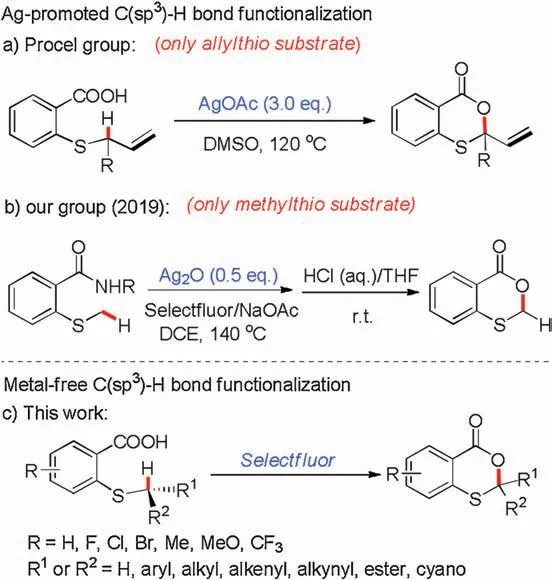
Scheme 1.Direct C(sp3)-H bond functionalization for the construction of 1,3-benzooxathiin-4-one derivatives.
With the optimized reaction conditions in hand, the substrate scope study on the sulfur atom substituents of 2-alkylthiobenzoic acid was carried out in Scheme 2.As expected, the substrates bearing different linear and branched alkyl substituents on the sulfur atom, including methyl,ethyl, n-propyl, n-butyl,n-hexyl,ipropyl and i-butyl,were transformed to the desired products 2a-g in good yields.Moreover,the substrates with a benzyl or phenethyl group also gave the desired products 2h-i in excellent yield.In addition, both cyano-and ester-substituted substrate were welltolerated to afford the desired products 2j and 2k in 81%and 63%yield.It was noteworthy that the highly reactive allyl and propargyl substrates could also provide the desired products 2l-m in good yield.
Next, the substrate scope of substituents on the aromatic ring was also tested (Scheme 3).Both electron withdrawing and electron-donating groups on the phenyl ring were compatible under the current reaction system,affording the desired products 2n-u in good yields.Notably,a variety of functional groups such as methyl, methoxy and halogen groups were well-suited for this reaction, allowing for further transformations of the initial products.However, the pyridine-containing substrate 1v failed to access the desired product 2v.
To provide some insights into the reaction mechanism,a series of control experiments were carried out(Scheme 4).Firstly,radical trapping experiments were performed, and the results showed that the addition of TEMPO inhibited this process,suggesting that a single electron transfer (SET) may be involved in the reaction(Scheme 4a).Furthermore, the reaction of sulfoxide 3 with Selectfluor failed to produce the desired product 2b, indicating that the sulfoxide intermediate may not be involved in this reaction (Scheme 4b).Next, the H/D exchange could not be detected when this reaction was performed with an isotopically labelled substrate [D]-1b (Scheme 4c).The KIE experiment between 1b and [D]-1b showed that the second-order of kineticisotope effect was observed and the cleavage of the C(sp3)-H bond may not be involved in a rate-determining step (Scheme 4d).
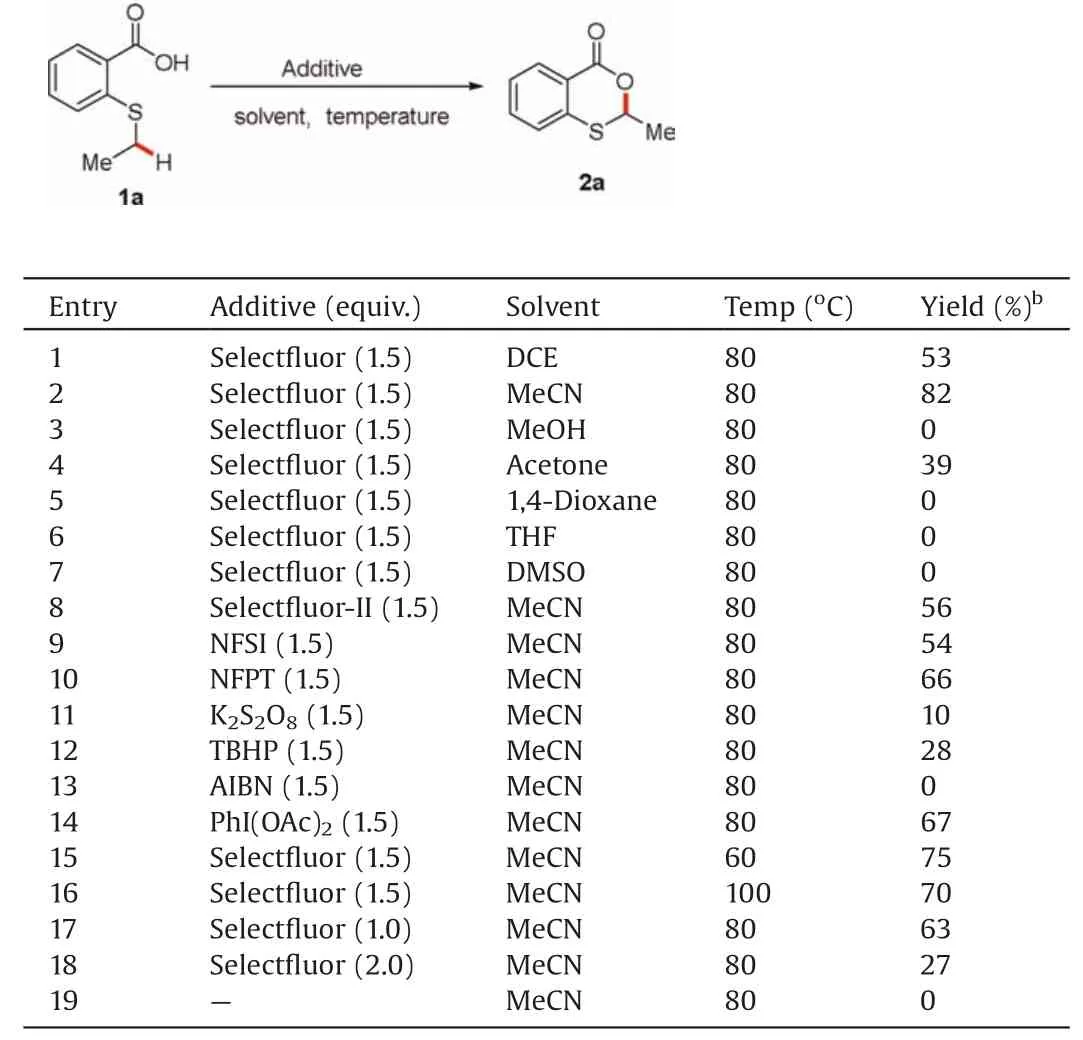
Table 1 Optimization of reaction conditions.a

Scheme 2.Substrate scope of substituents on the sulfur atom.Reaction conditions:1 (0.2 mmol), Selectfluor (0.3 mmol), MeCN (2.0 mL), 80°C,12 h.Isolated yield.
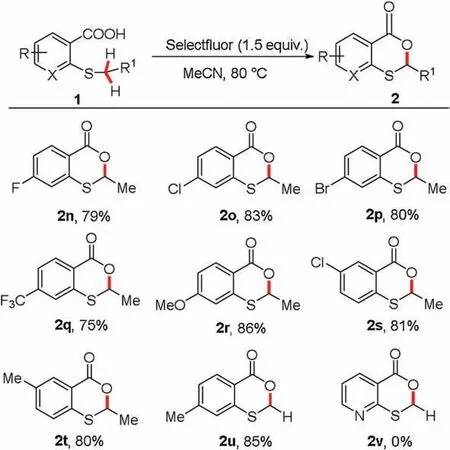
Scheme 3.Substrate scope of substituents on the aromatic ring.Reaction conditions: 1 (0.2 mmol), Selectfluor (0.3 mmol), MeCN (2.0 mL), 80°C, 12 h.Isolated yield.
On the basis of previous literatures[26,45-54]and our control experiments, a plausible mechanism has been depicted in Scheme 5.The initial oxidation of 2-methylthiobenzoic acid 1b by Selectfluor affords the radical A and radical cation B [45-48].Then the carbon-centered radical C can be formed through a 1,6-H radical shift process[49,50].Subsequently,the radical C is oxidized to the corresponding carbocation D and its isomer E in the presence of radical cation B and Selectfluor [51,52].Finally, an intramolecular cyclization of intermediate E and the sequential deprotonation provide the desired product 2b.However, a plausible pathway involving α-C-H fluorination and sequential intramolecular cyclization cannot be excluded at the present stage[53,46-54].
In order to illustrate the synthetic utility of this novel method,a gram-scale reaction for the synthesis of benzooxathiin-4-one 2b was carried out(Scheme 6).When 2-(methylthio)benzoic acid 1b(1.68 g,10 mmol)was treated with 1.5 equiv.of Selectfluor in MeCN(30 mL) at 80°C, the desired product 2b was obtained in 78%isolated yield.
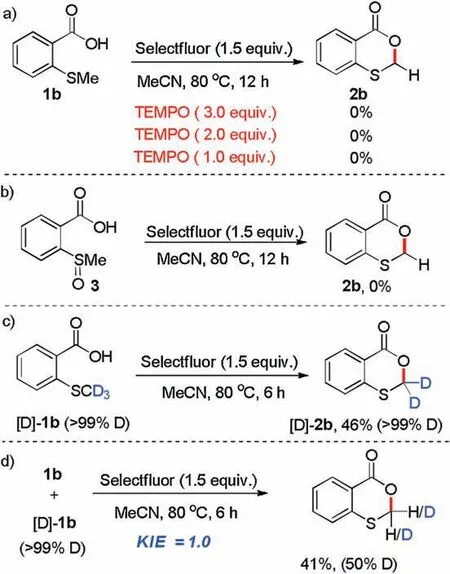
Scheme 4.Mechanistic studies.
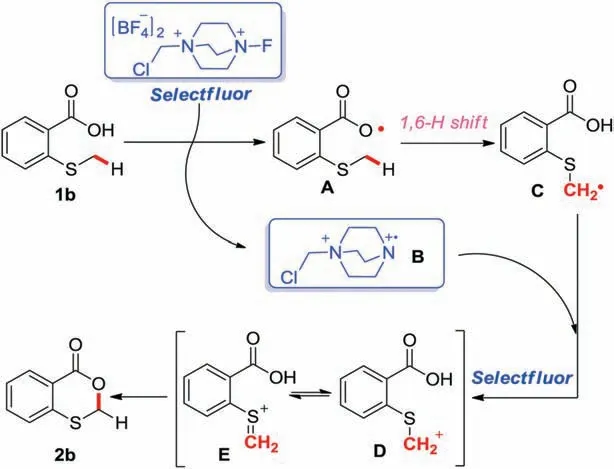
Scheme 5.The proposed mechanism.

Scheme 6.A gram-scale reaction for the synthesis of benzooxathiin-4-one 2b.
In summary, an efficient and direct cyclization of 2-alkylthiobenzoic acid via a Selectfluor-promoted α-C(sp3)-H functionalization has been developed.This process may involve a radical pathway in the presence of Selectfluor.Moreover, this metal-free strategy also provides an important complementary method to access various 1,3-benzooxathiin-4-one derivatives.
Declaration of competing interest
The authors report no declarations of interest.
Acknowledgments
We gratefully acknowledge the financial support from the National Natural Science Foundation of China (Nos.21572026,21702019),Advanced Catalysis and Green Manufacturing Collaborative Innovation Center, Changzhou University.
杂志排行
Chinese Chemical Letters的其它文章
- A biomass based photonic crystal made of “konjac tofu”
- Hydrothermal-assisted grinding route for WS2 quantum dots (QDs)from nanosheets with preferable tribological performance
- Superiority of poly(L-lactic acid) microspheres as dermal fillers
- Zwitterionic comb-like lipid polymers encapsulating linalool for increasing the fragrance retention time
- Construction of a nano-rectangular Zn-Nd complex with near-infrared luminescent response towards metal ions
- Synthesis and structure of Au19Ag4(S-Adm)15 nanocluster:Polymorphs and optical properties
